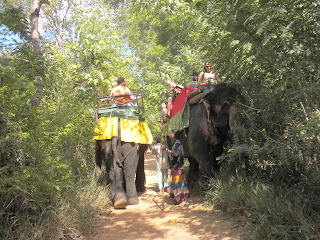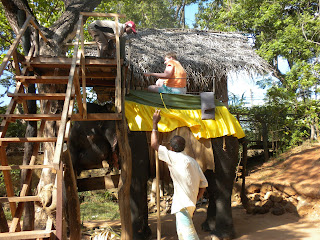As I got in the car on the appointed afternoon, I began to have doubts.
I am the person who rode a camel in Egypt and whose camel boy spurned the money our guide said was a fair price and refused to have the camel kneel until I gave him more. I was saved by a fellow-traveller who was able to argue with him in Arabic.
I am the person who fell off a horse that wasn’t moving in the Camargues. I dropped the reins to take a picture; he bent his head to graze and I rolled off his shoulder.
Naturally, I didn’t express these chicken-hearted thoughts to Lankesh as he told me about Sri Lankan elephants on our short trip to meet mine.
Elephants have been in Sri Lanka for over 5000 years. At first, they were the property of the Kings and the penalty for killing one was death. Much later, the British hunted elephants for sport. As agricultural lands took more of the jungle, Sri Lankans killed elephants who trampled their crops. By 2007 there were only about 3000 wild elephants left, many of them in two national parks. By law elephants cannot be used as pack animals any more but only ridden on ceremonial occasions – or by tourists. The tourist elephants are well taken care of. They are checked regularly by veterinarians and may only work 5 hours per day.
I arrived in time to see them prepare my elephant for me.
First she was given a bunch of palm leaves to eat to distract her.

While she ate, they got her ready.



Then it was time for me to climb up the steps and get on.

Well I’m as ready as I’ll ever be.

We started off.

The elephant driver walks beside the elephant with a pole to guide her. His assistant walks behind them with your camera to record your ride for posterity. That part they told me. The part they didn’t tell me was that the first 10 minutes of our ride would be ON THE ROAD –- with lorries honking and Sri Lankans waving and laughing from cars, buses and motorcycles while I repeated to myself that the elephant was used to this and nobody was going to get hurt.
My elephant eventually plodded sedately across the road to her familiar path and we were – well not in the jungle exactly but at least off the road.

A lady drawing water from a well looked up as we passed. A man stood, put his two hands together and bowed. I hoped that it was just the traditional greeting and not a prayer for my safety!
Just as I was beginning to relax, the assistant threw me a mango and told me to give it to my elephant. That meant I’d have to move!

Soon we reached the river and in she went.

When she came out I definitely felt a tilt.

But I’m glad I didn’t see this picture until I was safely on the ground.
Several times on our journey we met other tourists.
I am now part of the holiday photos of some Dutch people as they are part of mine.

Then it was back to the road again with small children following and laughing and more cars and lorries and busses. But I was almost relaxed by this time.
All too soon we were back where we started. Time to unfold my legs and try to get out of my cage.

No photo is available of the men hauling me up and out!
How did I feel? Well, I wasn’t actually humming “Let's Go for an Elephant Ride”. But I was smiling inside. I’d done it; I’d survived – and I was already planning this story.
Riding elephants in Sri Lanka, camels in Egypt, petting dolphins in the Caribbean, riding horses in Yellowstone National Park...(And the Camargues, where ever they are) we tourists ARE a funny bunch!
ReplyDelete